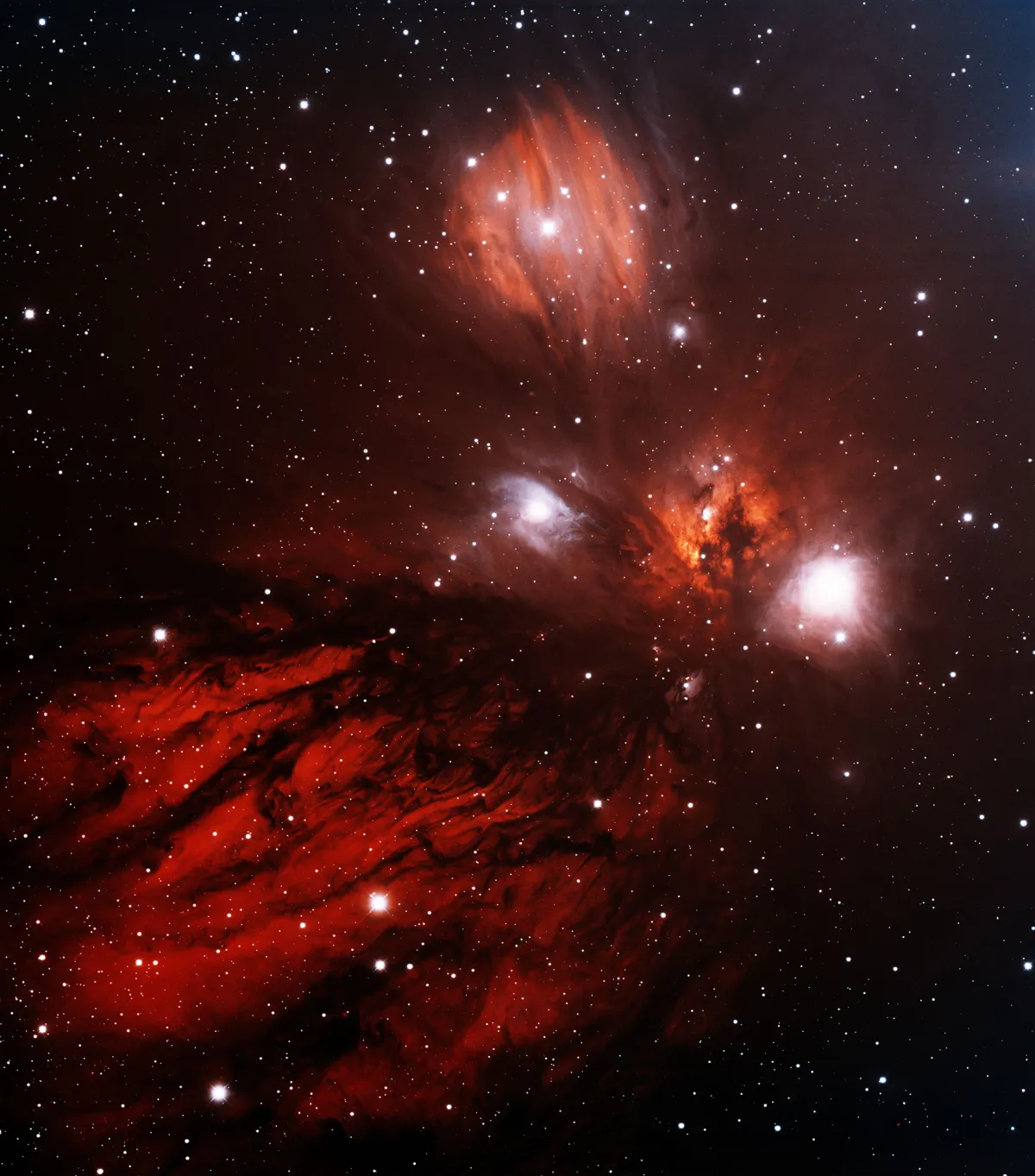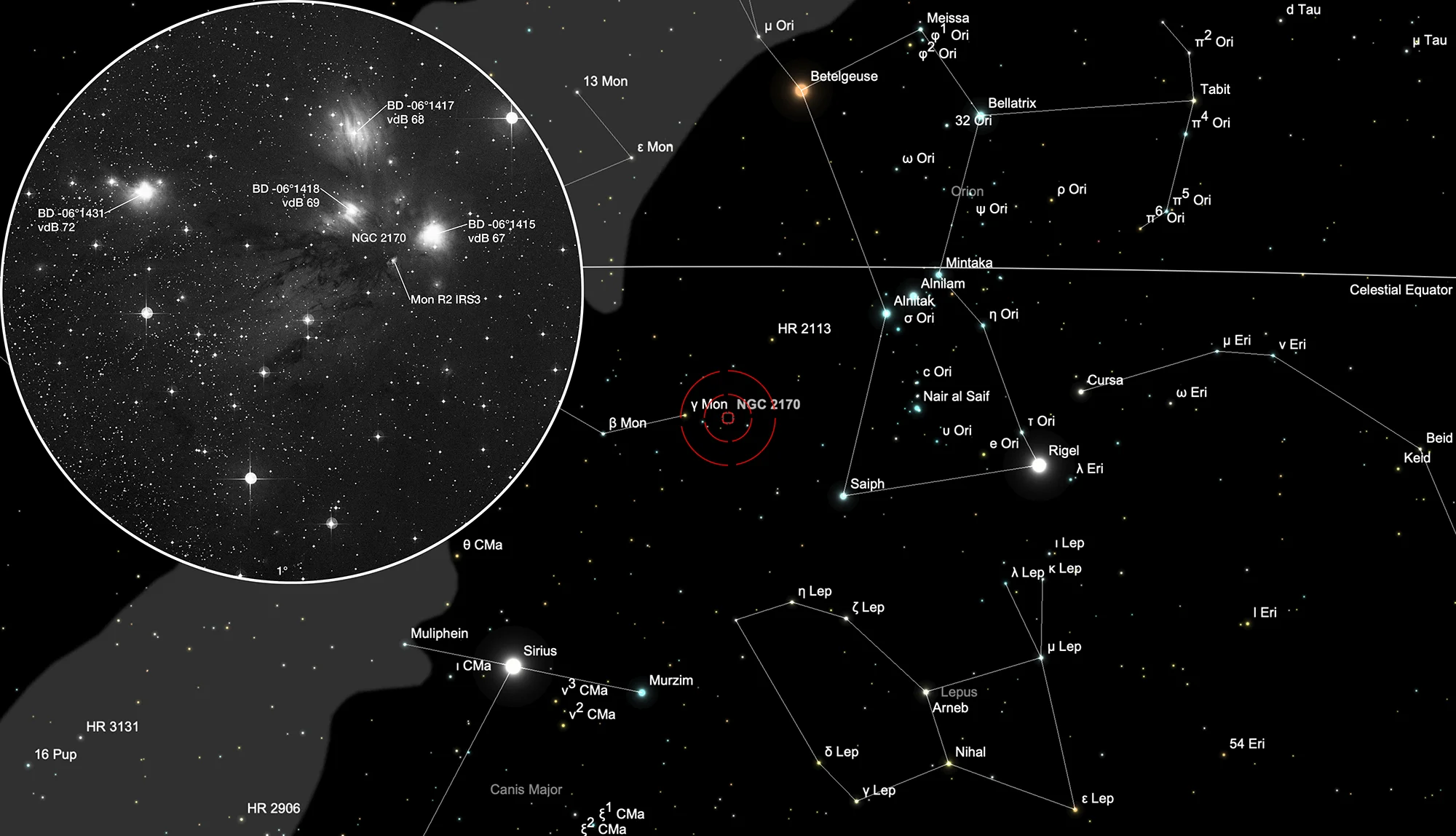Angel Nebula (NGC 2170)

History
William Herschel discovered IV 19 (NGC 2170) along with IV 20 (NGC 2185) on 16 October 1784. He was sweeping the sky with his 18.7-inch speculum reflector of 20 feet focal length in Datchet, near to Windsor Castle. For IV 19 (NGC 2170) he logged: «A star of the 9 magnitude, with much chevelure irregularly elliptical.» For IV 20 (NGC 2185) he logged. «A star of the 11 or 12 magnitude affected like the foregoing, but very faint.» [463] On 24 February 1786 Herschel logged IV 38 (NGC 2182) with the notes: «A considerable star affected with very faint milky chevelure.» On 28 November 1786 Herschel possibly observed IV 19 (NGC 2170) again, assumed it was new and logged it as IV 44 with the notes: «A star involved in much chevelure.» [464]
John Herschel observed IV 20 (NGC 2185) twice and listed it as h 383. On 20 February 1830 (sweep 235) he noted: «A star 10 magnitude with a very faint atmosphere. Two others south preceding are free from such atmosphere. A very faint nebula suspected south preceding this object.» On 8 January 1831 (sweep 318) he noted: «A star 10-11 magnitude has a very sensible nebulous burr, and 3 more are rather nebulous; others in the field are not so.» In the same night he aldo discovered h 378 (NGC 2167) and noted: «A star 7 magnitude with a pretty strong nebuluous atmosphere.» [466] In the General Catalogue John Herschel listed h 378 as GC 1359 with the notes: «Nebulous star 7 magnitude; among 3 stars.» [467] John Herschels position for h 378 matches star HD 41794 (which has no nebulosity) but he referred to his father's IV 44. Dreyer noticed this discrepancy and added a correction in 1912: «IV 44 cannot be h 378 but is probably a star of the 11th magnitude [HD 42004] 70s following it on the parallel.» [316]

On 11 December 1850 Irish engineer Bindon Blood Stoney tried to observe John Herschel's h 378, h 381 and h 383 with Lord Rosse's 72-inch reflector at Birr Castle. He noted: «I saw no nebulas round 378; south following about 20' is a triple star, the middle one of which is pretty strongly nebulous; about 36' following (a little north) is a double star, whose brighter component is nebulous; 65' following 378 is a small nebula with nucleus or stellar point.» [486] Heinrich d'Arrest independently found this reflection nebula (NGC 2183) on 11 January 1864 and measured an accurate position (as well as NGC 2185). He noted a mag 11-12 star 2.5' south and 1.4 sec of time preceding. Stoney's observation was not included in the GC (because of his rough location) and Dreyer only credited d'Arrest with the discovery in the GC Supplement and NGC. [364]
In 1946 Sven Cederblad published a study of bright diffuse galactic nebulae where he listed NGC 2170 as Cederblad 63. [130]
In 1965 Beverly T. Lynds published a catalogue of bright nebulae from a study of the red and blue prints of the Palomar Observatory Sky Atlas. The nebula is there referred as LBN 213.69-12.65 (or also just LBN 994). [270]
Just one year later in 1966 Sydney van den Bergh published his study of stars surrounded by reflection nebulae, also based on the red and blue prints of the Palomar Observatory Sky Atlas. He identified the following four nebulae: vdB 67, 68, 69, 70, 72, 73 and 74. For vdB 67 he was uncertain. [264]
Physical Properties
The reflection nebulae belong to the Monoceros R2 Molecular Cloud, which contains a cluster that is one of the closest massive star forming regions that is still embedded in its natal molecular cloud. The cluster contains several hundred stars which are obscured by dark clouds. The three brightest infrared sources in the Mon R2 region are IRS 1, IRS 2, and IRS 3. IRS 1 is the ionizing source of a compact HII region. IRS 2 illuminates the prominent ring nebulosity in the central part of the star forming region. IRS 3 is the brightest infrared source and probably the most luminous young stellar object in the cloud. It is optically invisible and has no associated HII region. This probably reflects the very early evolutionary stage of IRS 3, which apparently has not yet developed an HII region. [131]
| Name | RA | Dec | Type | vMag | Dim | MD | Dreyer Description | Identification, Remarks |
|---|---|---|---|---|---|---|---|---|
| NGC 2167 | 06 06 58.6 | -06 12 10 | * | 6.6 | Nebulous * 7, am 3 st | h 378; GC 1359; SAO 132848 | ||
| NGC 2170 | 06 07 31.3 | -06 23 53 | RN | 2 × 2 | 0.740 | * 9 in vF, pL neb, E 170° | WH IV 19; GC 1362; LBN 994 | |
| NGC 2182 | 06 09 30.9 | -06 19 35 | RN | 2 × 2 | 0.740 | pB **, L * neb, E 90° ± | WH IV 38; h 381; GC 1372; LBN 998 | |
| NGC 2183 | 06 10 46.9 | -06 12 43 | RN | 1 × 1 | 0.740 | eF, S, lE, * 11·12 sp | GC 5359; LBN 996 | |
| NGC 2185 | 06 11 00.4 | -06 13 36 | RN | 1 × 1 | 0.740 | * 11 and 4 S st in vF, L neb | WH IV 20; h 383; GC 1375; LBN 997; part of N 2185 |
Finder Chart
The reflection nebula NGC 2170 is located in the constellation Monoceros. The best season for observation is from October until March.
